Raptor
Administrator


Posts : 31
Joined : 2010-01-15
Age : 36
Gender : 
Location : India
 |  Subject: B-52 Stratofortress Subject: B-52 Stratofortress  Sun Jan 24, 2010 2:11 pm Sun Jan 24, 2010 2:11 pm | |
| B-25 STRATOFORTRESS  ------------------------------------------------------------------------------------------------------------------------------------------------------------------- DETAILS :Role : Strategic bomber
Manufacturer : Boeing
First flight : 15 April 1952
Introduction : February 1955
Status : Active
Reserve : 20
Primary users : United States Air Force , NASA
Produced : 1952-1962
Number built : 744
Unit cost B-52B : US$14.43 million
Unit cost B-52H : $9.28 million (1962)
Unit cost B-52H : $53.4 million (1998)
-------------------------------------------------------------------------------------------------------------------------------------------------------------------- SPECIFICATIONS :General Characteristics : Crew : 5 (pilot, copilot, radar navigator (bombardier), navigator, and Electronic Warfare Officer)
Length : 159 ft 4 in (48.5 m)
Wingspan : 185 ft 0 in (56.4 m)
Height : 40 ft 8 in (12.4 m)
Wing area : 4,000 sq?ft (370 m²)
Airfoil : NACA 63A219.3 mod root, NACA 65A209.5 tip
Empty weight : 185,000 lb (83,250 kg)
Loaded weight : 265,000 lb (120,000 kg)
Max takeoff weight : 488,000 lb (220,000 kg)
Powerplant : 8× Pratt & Whitney TF33-P-3/103 turbofans, 17,000 lbf (76 kN) each
Fuel capacity : 47,975 U.S. gal (39,948 imp gal; 181,610 L)
Zero-lift drag coefficient : 0.0119 (estimated)
Drag area : 47.60 sq?ft (4.42 m²)
Aspect ratio : 8.56 Performance : [Maximum speed : 560 kt (650 mph, 1,000 km/h[6])
Combat radius : 4,480 mi (3,890 NM, 7,210 km)
Ferry range : 10,145 mi (8,764 nm, 16,232 km)
Service ceiling : 50,000 ft[6] (15,000 m)
Rate of climb : 6,270 ft/min.[81] (31.85 m/s)
Wing loading : 120 lb/sq?ft (595 kg/m²)
Thrust/weight : 0.31
Lift-to-drag ratio : 21.5 (estimated)
Armament : Guns : 1× 20 mm M61 Vulcan cannon in a remote controlled tail turret now decommissioned and removed from all operational aircraft
Bombs : Approximately 70,000 pounds (31,500 kg) mixed ordnance -- bombs, mines, missiles, in various configurations .
Avionics : Electro-optical viewing system that uses platinum silicide forward-looking infrared and high resolution low-light-level television sensors .
-------------------------------------------------------------------------------------------------------------------------------------------------------------------- BACKGROUND On 23 November 1945, Air Materiel Command (AMC) issued desired performance characteristics for a new strategic bomber "capable of carrying out the strategic mission without dependence upon advanced and intermediate bases controlled by other countries".[7] The aircraft was to have a crew of five plus turret gunners, and a six-man relief crew. It had to cruise at 300 mph (240 kn, 480 km/h) at 34,000 feet (10,400 m) with a combat radius of 5,000 statute miles (4,300 nmi, 8,000 km). The armament was to consist of an unspecified number of 20 mm cannon and 10,000 pounds (4,500 kg) of bombs.[8] On 13 February 1946, the Air Force issued bid invitations for these specifications, with Boeing, Consolidated Aircraft, and Glenn L. Martin Company submitting proposals.
On 5 June 1946, Boeing's Model 462, a straight-wing aircraft powered by six Wright T35 turboprops with a gross weight of 360,000 pounds (160,000 kg) and combat radius of 3,110 statute miles (2,700 nmi, 5,010 km), was declared the winner. On 28 June 1946, Boeing was issued a letter of contract for US$1.7 million (1946 dollars) to build a full-scale mock-up of the new XB-52 and do preliminary engineering and testing. However, by October 1946, the Air Force began to express concern about the sheer size of the new aircraft and its inability to meet the specified design requirements. In response, Boeing produced Model 464, a smaller four-engine version with a 230,000 pound (105,000 kg) gross weight, which was briefly deemed acceptable.
Then, in November 1946, the Deputy Chief of Air Staff for Research and Development, General Curtis LeMay, expressed the desire for a cruise speed of 400 miles per hour (345 kn, 645 km/h), to which Boeing responded with a 300,000 pound (140,000 kg) aircraft. In December 1946, Boeing was asked to change their design to a four-engine bomber with a top speed of 400 miles per hour, range of 12,000 statute miles (10,000 nmi, 19,000 km), and the ability to carry a nuclear weapon. The aircraft could weigh up to 480,000 pounds (220,000 kg). Boeing responded with two models powered by the T-35 turboprops. The Model 464-16 was a "nuclear-only" bomber with a 10,000 pound payload, while the Model 464-17 was a general purpose bomber with a 90,000 pound (40,000 kg) payload. Due to the cost associated with purchasing two specialized aircraft, the Air Force selected Model 464-17 with the understanding that it could be adapted for nuclear strikes.
In June 1947, the military requirements were updated and the Model 464-17 met all of them except for the range. It was becoming obvious to the Air Force that, even with the updated performance, the XB-52 would be obsolete by the time it entered production and would offer little improvement over the Convair B-36. As a result, the entire project was put on hold for six months. During this time, Boeing continued to perfect the design which resulted in the Model 464-29 with a top speed of 455 miles per hour (395 kn, 730 km/h) and a 5,000-mile range. In September 1947, the Heavy Bombardment Committee was convened to ascertain performance requirements for a nuclear bomber. Formalized on 8 December 1947, these called for a top speed of 500 miles per hour (440 kn, 800 km/h) and an 8,000 statute mile (7,000 nmi, 13,000 km) range, far beyond the capabilities of 464-29.
The outright cancellation of the Boeing contract on 11 December 1947 was staved off by a plea from its president William McPherson Allen, and in January 1948 Boeing was instructed to thoroughly explore recent technological innovations, including aerial refueling and the flying wing. Noting stability and control problems Northrop was experiencing with their YB-35 and YB-49 flying wing bombers, Boeing insisted on a conventional aircraft, and in April 1948 presented a US$30 million (1948 dollars) proposal for design, construction, and testing of two Model 464-35 prototypes. Further revisions of specifications during 1948 resulted in an aircraft with a top speed of 513 miles per hour (445 kn, 825 km/h) at 35,000 feet (10,700 m), a range of 6,909 statute miles (6,005 nmi, 11,125 km), and a 280,000 pounds (125,000 kg) gross weight which included 10,000 pounds of bombs and 19,875 US gallons (75,225 L) of fuel.-------------------------------------------------------------------------------------------------------------------------------------------------------------------- DESIGN Upgrades And Modifications ::
In November 1959, SAC initiated the Big Four modification program (also known as Modification 1000) for all operational B-52s except early B models. The program was completed by 1963. The four modifications were:
1. Ability to perform all-weather, low-altitude (below 500 feet or 150 m) interdiction as a response to advancements in
Soviet Union's missile defenses. The low-altitude flights were estimated to accelerate structural fatigue by at least a
factor of eight, requiring costly repairs to extend service life.
2. Ability to launch AGM-28 Hound Dog standoff nuclear missiles
3. Ability to launch ADM-20 Quail decoys
4. An advanced electronic countermeasures (ECM) suite
The ability to carry up to 20 AGM-69 SRAM nuclear missiles was added to G and H models starting in 1971. Fuel leaks due to deteriorating Marman clamps continued to plague all variants of the B-52. To this end, the aircraft were subjected to Blue Band (1957), Hard Shell (1958), and finally QuickClip (1958) programs. The latter fitted safety straps which prevented catastrophic loss of fuel in case of clamp failure.
Ongoing problems with advanced avionics were addressed in the Jolly Well program, completed in 1964, which improved components of the AN/ASQ-38 bombing navigational computer and the terrain computer. The MADREC (Malfunction Detection and Recording) upgrade fitted to most aircraft by 1965 could detect failures in avionics and weapons computer systems, and was essential in monitoring the Hound Dog missiles. The electronic countermeasures capability of the B-52 was expanded with Rivet Rambler (1971) and Rivet Ace (1973).
In order to improve the ability to operate safely at low level during both day and night, the AN/ASQ-151 Electro-Optical Viewing System (EVS), consisting of a Low Light Level Television (LLLTV) and a Forward Looking Infra-Red (FLIR) system mounted in blisters under the noses of B-52Gs and Hs between 1972 and 1976. In order to further improve the B-52s offensive ability, it was decided to fit Air Launched Cruise Missiles (ALCMs). After testing of both the Air-Force backed Boeing AGM-86 and the Navy backed General Dynamics AGM-109 Tomahawk, the AGM-86B was selected for operation by the B-52 (and ultimately by the B-1 Lancer). A total of 194 B-52Gs and Hs were modified to carry AGM-86s, carrying 12 missiles on underwing pylons, with 82 B-52Hs further modified to carry another eight missiles on a rotary launcher fitted in the aircraft's bomb-bay. In order to conform with the requirements of the SALT II Treaty for cruise missile capable aircraft to be readily identified by reconnaissance satellites, the cruise missile armed B-52Gs were modified with a distinctive wing root fairing. As all B-52Hs were assumed to be modified, no visual modification of these aircraft was required.[36] In 1990, the stealthy AGM-129 ACM cruise missile entered service. Although originally intended to replace the AGM-86 its high cost and the end of the Cold War stopped production after only 450 had been made. Unlike the AGM-86, no conventional (i.e. non-nuclear) armed version was built.
Structural fatigue, exacerbated by the change to low-altitude missions, was first dealt with in the early 1960s by the three-phase High Stress program which enrolled aircraft at 2,000 flying hours. This was followed by a 2,000-hour service life extension to select airframes in 1966-1968, and the extensive Pacer Plank reskinning completed in 1977. The wet wing introduced on G and H models was even more susceptible to fatigue due to experiencing 60% more stress during flight than the old wing. The wings were modified by 1964 under ECP 1050.[39] This was followed by a fuselage skin and longeron replacement (ECP 1185) in 1966, and B-52 Stability Augmentation and Flight Control program (ECP 1195) in 1967.
Boeing has suggested re-engining the B-52H fleet with the Rolls-Royce RB211 534E-4. This would involve replacing the eight Pratt & Whitney TF33s (total thrust 8 × 17,000 lb) with four RB211s (total thrust 4 × 37,400lb). The RR engines will increase the range and payload of the fleet and reduce fuel consumption. However, the cost of the project would be significant. Procurement would cost approximately US$2.56 billion (US$36 million × 71 aircraft). A Government Accountability Office study of the proposal concluded that Boeing's estimated savings of US$4.7 billion would not be realized. They found that it would cost the Air Force US$1.3 billion over keeping the existing engines.This was subsequently disputed in a Defense Sciences Board report in 2003 and revised in 2004 that identified numerous errors in the prior evaluation of the Boeing proposal, and urged the Air Force to re-engine the aircraft without delay. Further, the DSB report stated the program would save substantial funds, reduce greenhouse gas emissions, and increase aircraft range and endurance, duplicating the results of a Congressionally funded US$3M program office study conducted in 2003. However, the re-engining has been approved as of 2009.
In 2007 the LITENING targeting pod was fitted and commissioned increasing the combat effectiveness of the aircraft during day, night and under-the-weather conditions in the attack of ground targets with a variety of standoff weapons under the guidance of LASERs and the help of high resolution forward-looking infrared sensor (FLIR) for visual display in the infrared portion of the electromagnetic spectrum and charged coupled device (CCD-TV) camera used to obtain target imagery in the visible portion, this technology could also be used in real-time transmission to ground communications networks and government agencies to gather battlefield intelligence, assess battlefield damage, assess terrorist activities and counter drug activity, further advancing the B-52H's capabilities and uses.
Fuel Research Platform ::
In September 2006, the B-52 became one of the first US military aircraft to fly using 'alternative' fuel. Syntroleum Corporation, a leader in Fischer-Tropsch process (FT) technology, announced that its Ultra-Clean jet fuel had been successfully tested in a B-52. It took off from Edwards Air Force Base with a 50/50 blend of FT and traditional JP-8 jet fuel which was burned in two of the eight engines on the aircraft. This marked the first time that FT jet fuel was tested in a military flight demo, and is the first of several planned test flights.
On 15 December 2006, tail number 61-0034, Wise Guy took off from Edwards with the synthetic fuel blend powering all eight engines, the first time an Air Force aircraft was completely powered by the mixture. The test flight was captained by Major General Curtis Bedke, commander of the Edwards Flight Test Center, the first time in 36 years that the installation's commander performed a first flight in a flight test program. The flight lasted seven hours, reached an altitude of 48,000 feet, and was considered a success.
On 8 August 2007, Air Force Secretary Michael Wynne certified the B-52H as fully approved to use the FT blend, marking the formal conclusion of the test program.
This program is part of the Department of Defense Assured Fuel Initiative, an effort to develop secure domestic sources for the military energy needs. The Pentagon hopes to reduce its use of crude oil from foreign producers and obtain about half of its aviation fuel from alternative sources by 2016. With the B-52 now approved to use the FT blend, the USAF will use the test protocols developed during the program to certify the C-17 Globemaster III and then the B-1B to use the fuel (the first B-1 test flight took place in March, 2008). The Air Force intends to test and certify every airframe in its inventory to use the fuel by 2011.
-------------------------------------------------------------------------------------------------------------------------------------------------------------------- VARIANTS The B-52 went through several design changes and variants over its 10 years of production.
B-52A ::
Only three of the first production version, the B-52A, were built, all loaned to Boeing for flight testing. The first production B-52A differed from prototypes in having redesigned forward fuselage. The bubble canopy and tandem seating was replaced by a side-by-side arrangement and a 21 inch (53 cm) nose extension accommodated more avionics and a new 6th crew member. In the rear fuselage a tail turret with four 0.50 inch (12.7 mm) machine guns with a fire-control system, and a water injection system to augment engine power with a 360 US gallon (1,363 L) water tank was added. The aircraft also carried a 1,000 US gallon (3,785 L) external fuel tank under each wing. The tanks acted as dampeners to reduce wing flex and also kept wingtips close to the ground for ease of maintenance.
NB-52A ::
The last B-52A (serial 52-0003) was modified and redesignated NB-52A in 1959 to carry the North American X-15. A pylon was fitted under the right wing between the fuselage and the inboard engines with a 6 feet x 8 feet (1.8 m x 2.4 m) section removed from the right wing flap to fit the X-15 tail. Liquid oxygen and hydrogen peroxide tanks were installed in the bomb bays to fuel the X-15 before launch. First flight with X-15 was on 19 March 1959, with the first launch on 8 June 1959. The NB-52A, named "The High and Mighty One" carried the X-15 on 93 of the program's 199 flights.
B-52B/RB-52B ::
The B-52B was the first version to enter service with the USAF on 29 June 1955, with the 93rd Bombardment Wing at Castle AFB in California. This version included minor changes to engines and avionics in the attempt to fix minor problems. Temporary grounding of the aircraft after a crash in February 1956 and again the following July caused training delays, and at mid-year there were still no combat-ready B-52 crews.
Of the 50 B-52Bs built, 27 were capable of carrying a reconnaissance pod as RB-52Bs (the crew was increased to eight in these aircraft). The 300 pound (136 kg) pod contained radio receivers, a combination of K-36, K-38, and T-11 cameras, and two operators on downward-firing ejection seats. The pod required only four hours to install.
Seven B-52Bs were brought to B-52C standard under Project Sunflower.
NB-52B ::
The NB-52B was B-52B number 52-0008 converted to an X-15 launch platform. It subsequently flew as the "Balls 8" in support of NASA research until 17 December 2004, making it the oldest flying B-52B. It was replaced by a modified B-52H.
B-52C ::
In the B-52C the fuel capacity (and range) was increased to 41,700 US gallons by adding larger 3000 US gallon underwing fuel tanks. The gross weight was increased by 30,000 pounds (13,605 kg) to 450,000 pounds. The belly of the aircraft was painted with antiflash white paint, which was intended to reflect thermal radiation away after a nuclear detonation.
RB-52C ::
The RB-52C was the designation given, but seldom used, to B-52Cs converted for reconnaissance duties in a similar manner to RB-52Bs.
B-52D ::
The B-52D was a dedicated long-range bomber without a reconnaissance option. The Big Belly modifications allowed the B-52D to carry heavy loads of conventional bombs for carpet bombing over Vietnam. Aircraft assigned to Vietnam were painted camouflage with black bellies to defeat searchlights.
B-52E ::
In the B-52E the aircraft had an updated avionics and bombing navigational system, which was eventually debugged and included on following models.
One E aircraft (AF Serial No. 56-0631) modified as a testbed for various B-52 systems. Redesignated NB-52E, the aircraft was fitted with canards and a Load Alleviation and Mode Stabilization system (LAMS) which reduced airframe fatigue from wind gusts during low level flight. In one test, the aircraft flew 10 knots (11.5 mph, 18.5 km/h) faster than the never exceed speed without damage because the canards eliminated 30% of vertical and 50% of horizontal vibrations caused by wind gusts.
B-52F ::
In the B-52F, the aircraft was given J57-P-43W engines with a larger capacity water injection system and new alternators. The aircraft had a problem with fuel leaks, which were eventually solved by service modifications Blue Band, Hard Shell, and QuickClip.
B-52G ::
The B-52G was proposed to extend the B-52's service life during delays in the B-58 Hustler program. At first, a radical redesign was envisioned with a completely new wing and Pratt & Whitney J75 engines. This was rejected to avoid slowdowns in production, although changes were implemented. The most significant of these was the brand new "wet" wing with integral fuel tanks which considerably increased the fuel capacity — gross aircraft weight went up by 38,000 pounds (17,235 kg) compared with prior variants. In addition, a pair of 700 US gallon (2,650 L) external fuel tanks was fitted under the wings. The wing also had the traditional ailerons eliminated, instead utilizing spoilers for roll control. The tail fin was shortened by 8 feet (2.4 m), water injection system capacity was increased to 1,200 US gallons (4,540 L), and the nose radome was enlarged. The tail gunner was provided with an ejection seat and moved to the main cockpit. Dubbed the "Battle Station" concept, the offensive crew (pilot and copilot on the upper deck and the two bombing navigation system operators on the lower deck) faced forward, while the defensive crew (tail gunner and ECM operator) on the upper deck faced aft. The B-52G entered service 13 February 1959 (a day earlier, the last B-36 was retired, making SAC an all-jet bomber force). Nearly all B-52Gs were destroyed in compliance with the Strategic Arms Reduction Treaty of 1992. A few examples remain in museums and as static displays at various air force bases.
B-52H ::
The B-52H had the same crew and structural changes as the B-52G. The most significant upgrade was the switch to TF33-P-3 turbofan engines which, despite the initial reliability problems (corrected by 1964 under the Hot Fan program), offered considerably better performance and fuel economy than the J57 turbojets. The ECM and avionics were updated, a new fire control system was fitted, and the rear defensive armament was changed from machine guns to a 20 mm M61 Vulcan cannon. A provision was made for four AGM-48 Skybolt ballistic missiles. First flight 10 July 1960, entered service 9 May 1961. This is the only variant still operational.
A total of 744 B-52s were built. The last production aircraft, B-52H AF Serial No. 61-0040, left the factory on 26 October 1962.
EB-52H ::
Was a proposed variant of the B-52H that would have modified 16 aircraft with electronic jamming capabilities. It would have given the USAF an airborne jamming capability that it has lacked since retiring the EF-111 Raven. The program was cancelled in 2005 following removal of funding for the stand-off jammer, it was revised in 2007 but funding was removed again in early 2009.-------------------------------------------------------------------------------------------------------------------------------------------------------------------- IMAGE GALLERY  . 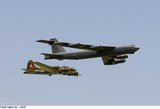 . 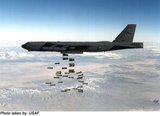 . 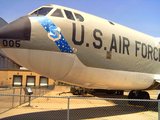  .  .  . 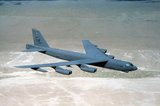 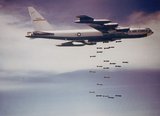 . 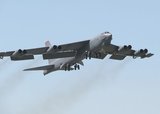 .  .  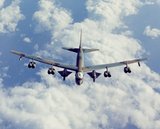 | |
|
